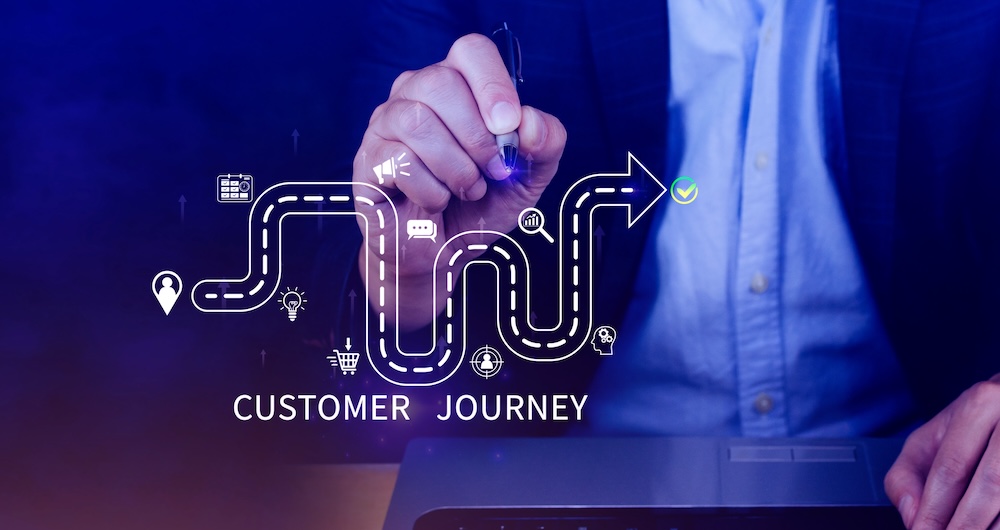
Did you know that 80% of companies think they deliver great customer experiences, but only 8% of customers agree? (According to a Bain & Company survey)
That’s a huge disconnect. How can we close this gap? Imagine being able to see your business exactly the way your customers do—every step they take, every frustration they feel, and every moment that makes them smile. A powerful tool to achieve this is customer journey mapping, and it can make all the difference.
What is it? Does it really matter? How can you get started? And what is the role of technology? In this article, I’ll share what I’ve learned, and what I think will help you as well. If we can truly get a sense for what our customer’s journey is like, we can truly make their experience better. Not just in theory, but also in reality as well.
What is Customer Journey Mapping?
Customer journey mapping is a way to see your business through your customer’s eyes. It’s a visual map of every step they take—from discovering your brand to solving their problem or completing a purchase.
A journey map shows:
- What your customers are doing: The actions they take at each stage.
- What they’re feeling: Points of frustration, confusion, or excitement.
- What they need: Opportunities to improve their experience.
By understanding the full journey, you can find what’s working, fix what’s not, and create a smoother, more enjoyable experience for your customers. For contact centers, it connects all the dots—calls, chats, emails, and more—so you can deliver better service at every touchpoint.
Why Customer Journey Mapping Matters
If you are like me, that sounds great but also like a lot of work and possible cost. Does it really matter? The truth is that being able to see things from your customer’s eyes has solid benefits. What can it help you to do?
- Understand Your Customers Better: See what they experience at every step—good or bad.
- Spot Problems and Fix Them Fast: Find where customers get stuck or frustrated and make improvements.
- Build Empathy Across Your Team: When everyone understands what customers go through, it’s easier to work together to help them.
- Create a Smoother Customer Experience (CX): Customers will notice when things feel seamless, and they’ll stick around longer.

All of these have real measurable impacts on your bottom line. If you know your customers well, you can really provide products and services they need and will buy. If their experience is smooth, they are more likely to finish a purchase or to stay loyal. All of this is good both for business and for the customer. It’s a win-win for all.
And in the Contact Center, it is especially important. It’s easy for a customer to become frustrated. After all, they may have only contacted you because they are having a problem! If you can see their journey, across calls, chats, and messages, you can expedite the resolution and smooth over the issue.
When you fix the little things, you also make big improvements. Happier customers. Less stress for employees. And a stronger business overall.
Key Benefits of Customer Journey Mapping for Contact Centers
Customer journey mapping isn’t just about knowing what customers do—it’s about making their experience better. Here’s how it helps contact centers:
- Better Customer Experiences (CX): When you understand what customers need, you can make every interaction feel personal and helpful. That means happier, more loyal customers.
- Faster, More Efficient Service: Journey maps show where processes slow down or overlap. Fixing these areas saves time and reduces costs.
- Proactive Problem-Solving: Instead of waiting for customers to complain, you can see potential problems early and fix them before they happen.
- Stronger Employee Engagement: A clear map makes it easier for agents to understand their role in the bigger picture, which leads to more motivated teams.
For example, if a journey map shows customers dropping off after a chatbot interaction, you can make adjustments. Using tools like LivePerson’s Conversational Cloud or Bright Pattern’s omnichannel solutions, you could smooth that transition by escalating faster from the chatbot to a live agent.
Real-Life Applications in Mid-Sized Contact Centers
Customer journey mapping isn’t just an idea—it’s something you can put to work in real, practical ways. Let’s look at some examples of how mid-sized contact centers are using journey mapping to create better experiences. Of course, any size of business or customer service team can benefit.
- Personalizing Every Interaction: By understanding what customers need at each stage, such as using LivePerson’s intent recognition features, you can offer just what your customers need.
- Making Omnichannel Consistent: Many contact centers struggle to connect voice, chat, email, messaging, and social media channels. Journey maps highlight these gaps so you can fix them with solutions like an omnichannel platform. This way your customers don’t have to repeat themselves across channels.
- Improve Remote Support with AR Tools: Imagine a customer needing help with a product installation. A journey map might show this as a pain point. With tools like CareAR, experts can provide real-time, visual support using augmented reality. This can make complex issues easy to solve, since the experts can see the problems with their own eyes.
These are just a few ways journey mapping helps. It takes what feels like a messy web of interactions and turns it into a clear path. That clarity can make all the difference.
How to Start Mapping Your Customer’s Journey
Getting started with customer journey mapping doesn’t have to be overwhelming. Here’s a simple way to begin:
- Gather Data from Every Touchpoint: Look at all the ways customers interact with your business—calls, chats, messaging, emails, social media, and even in-person visits. Use feedback from surveys, CRM data, and analytics to see what’s working and where customers might be struggling.
- Create a Clear Visual Map: Lay out each step of the customer’s journey, from their first interaction to the final resolution. You can use tools like flowcharts or journey mapping software to make it easy to see the big picture.
- Highlight Pain Points and Opportunities: Find areas where customers face delays, confusion, or frustration. These are your chances to make quick, meaningful improvements.
- Prioritize Changes That Matter Most: Focus on fixes that have the biggest impact on customer satisfaction and efficiency. Sometimes, small adjustments—like faster chatbot-to-agent handoffs—can make a huge difference.
- Test, Learn, and Improve Continuously: The map isn’t set in stone. Keep updating it as you gather more data and feedback to stay aligned with customer needs.

By following these steps, you’ll gain valuable insights and set the foundation for a better customer experience. Tools and systems, like those integrated by CBA, can help you bring these maps to life, making sure that every touchpoint supports your goals.
The Role of Technology in Customer Journey Mapping
Technology plays a big role in turning customer journey maps into action. With the right tools, you can uncover insights, improve experiences, and make lasting changes. Here’s how:
- Connect the Dots Across Channels: Omnichannel platforms like Bright Pattern bring all customer interactions—calls, chats, messages, emails, and more—into one system. This helps you see how each step in the journey connects and ensures a seamless experience.
- Personalize at Scale with AI: Tools like LivePerson’s Conversational Cloud use AI to understand customer intent and guide interactions. Whether it’s a chatbot answering common questions, or a handoff to the agent with the right skills, AI ensures the journey feels smooth and tailored.
- Solving Problems Faster with AR: For field service or product support, platforms like CareAR enhance remote assistance with augmented reality. This brings expert guidance directly to the customer, reducing frustration and resolving issues quickly.
- Streamlining Workflows for Employees: Technology doesn’t just help customers—it also makes employees’ jobs easier. Integrated systems reduce manual tasks, allowing teams to focus on delivering excellent service.
At CBA, we specialize in integrating these tools to fit your business. By connecting technology to your journey map, we help create a system that works seamlessly for both your customers and your employees. The result? A smoother journey, happier customers, and a stronger business.
Let’s Map Your Success Together
Customer journey mapping isn’t just about fixing problems—it’s about creating better experiences for everyone involved. When you map out your customer’s path, you discover ways to making things better for them at every turn. And with the right tools and strategies in place, those opportunities become reality.
At CBA, we’re here to help you take the first step. Whether it’s integrating AI-powered platforms, building consistent, or enhancing remote support AR, we’ll guide you toward solutions that meet your business needs.
Let’s work together to turn your customer journey map into a powerful tool for growth. Ready to get started?


